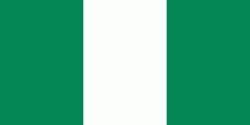Ogbomosho (Ogbomoso)
Ogbomosho (also Ògbómọ̀ṣọ́) is a city in Oyo State, south-western Nigeria. It was founded in the mid 17th century. The population was approximately 454,690 in the 2006 census. It is the second largest city in Oyo State and also among the most populated in Nigeria. Although the principal inhabitants of the city are the Yoruba people, there are people from other parts of Nigeria and other West African countries who are resident in the city.
According to an early missionary, "Ogbomosho in 1891 was a walled city, the gates of which were closely watched by day and securely closed by night. The town, picturesque and well watered was isolated from the rest of the Yoruba towns. Political relations were maintained with the Ibadans, for the country depended on its security on the warriors of Ogbomosho and Ikirun... The strength of Ogbomosho lay in the wall and moat surrounding the town, and the warriors made full use of it by sitting close and tight.."
The tale behind the name Ogbomoso
Olabanjo Ogunlola Ogundiran was of Ibariba descent. He and his wife, Esuu, built their hut by the side of the ajagbon tree.
Ogunlola (later Soun) noticed smoke oozing from some nearby locations. He took courage and approached these places and discovered other hunters. There is no more Bale Akande.
Egbe Alongo (Alongo Society)
Ogunlola, after the discovery of these hunters, took the initiative to invite them to form the Alongo Society. The primary objectives of the society were: defence against Sunmoni (slave prowlers) raids group hunting of wild animals, and mutual assistance. After each day's hunting, they retired to Ogunlola's hut where they were treated to beans and other meals and were served with Sekete wine brewed by Ogunlola's wife from fermented guinea corn. They also engaged in discussing current affairs and planning.
Orisapopo
Esuu, the wife of Ogunlola, introduced the worship of Orisapopo to Ogbomoso. The worshippers were distinguished by white beads worn round their necks and wearing of white dresses only. Drinking of palm wine was forbidden to them. The name Orisapopo was probably derived from the fact that Ogunlola's hut was on the northsouthern route, therefore the Orisala being worshipped in the hut was named “Orisapopo” (idol by the highway). The importance and influence of ‘Orisapopo’ among the citizens of Ogbomoso is immense. It can be described as the patron “Orisa” of Ogbomoso.
How Ogunlola's settlement became Ogbomosos and Ogunlola became Soun
According to an early missionary, "Ogbomosho in 1891 was a walled city, the gates of which were closely watched by day and securely closed by night. The town, picturesque and well watered was isolated from the rest of the Yoruba towns. Political relations were maintained with the Ibadans, for the country depended on its security on the warriors of Ogbomosho and Ikirun... The strength of Ogbomosho lay in the wall and moat surrounding the town, and the warriors made full use of it by sitting close and tight.."
The tale behind the name Ogbomoso
Olabanjo Ogunlola Ogundiran was of Ibariba descent. He and his wife, Esuu, built their hut by the side of the ajagbon tree.
Ogunlola (later Soun) noticed smoke oozing from some nearby locations. He took courage and approached these places and discovered other hunters. There is no more Bale Akande.
Egbe Alongo (Alongo Society)
Ogunlola, after the discovery of these hunters, took the initiative to invite them to form the Alongo Society. The primary objectives of the society were: defence against Sunmoni (slave prowlers) raids group hunting of wild animals, and mutual assistance. After each day's hunting, they retired to Ogunlola's hut where they were treated to beans and other meals and were served with Sekete wine brewed by Ogunlola's wife from fermented guinea corn. They also engaged in discussing current affairs and planning.
Orisapopo
Esuu, the wife of Ogunlola, introduced the worship of Orisapopo to Ogbomoso. The worshippers were distinguished by white beads worn round their necks and wearing of white dresses only. Drinking of palm wine was forbidden to them. The name Orisapopo was probably derived from the fact that Ogunlola's hut was on the northsouthern route, therefore the Orisala being worshipped in the hut was named “Orisapopo” (idol by the highway). The importance and influence of ‘Orisapopo’ among the citizens of Ogbomoso is immense. It can be described as the patron “Orisa” of Ogbomoso.
How Ogunlola's settlement became Ogbomosos and Ogunlola became Soun
Map - Ogbomosho (Ogbomoso)
Map
Country - Nigeria
 |
 |
| Flag of Nigeria | |
Nigeria has been home to several indigenous pre-colonial states and kingdoms since the second millennium BC, with the Nok civilization in the 15th century BC, marking the first internal unification in the country. The modern state originated with British colonialization in the 19th century, taking its present territorial shape with the merging of the Southern Nigeria Protectorate and Northern Nigeria Protectorate in 1914 by Lord Lugard. The British set up administrative and legal structures while practising indirect rule through traditional chiefdoms in the Nigeria region. Nigeria became a formally independent federation on 1 October 1960. It experienced a civil war from 1967 to 1970, followed by a succession of military dictatorships and democratically elected civilian governments until achieving a stable democracy in the 1999 presidential election. The 2015 general election was the first time an incumbent president failed to be re-elected.
Currency / Language
| ISO | Currency | Symbol | Significant figures |
|---|---|---|---|
| NGN | Nigerian naira | ₦ | 2 |
| ISO | Language |
|---|---|
| EN | English language |
| HA | Hausa language |
| IG | Igbo language |
| YO | Yoruba language |















